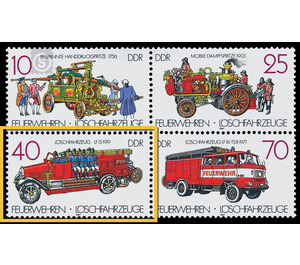Fire brigades: fire trucks - Germany / German Democratic Republic 1987 - 40 Pfennig
Theme: Organiszations & Institutions
| Country | Germany / German Democratic Republic |
| Issue Date | 1987 |
| Face Value | 40.00 |
| Color | red |
| Perforation | K 13:12 1/2 |
| Printing Type | offset |
| Stamp Type | Postage stamp |
| Item Type | Stamp |
| Chronological Issue Number | 2845 |
| Chronological Chapter | GER-DDR |
| SID | 294051 |
| In 16 Wishlists | |
Fire brigades and firefighting vehicles The Ministry of Posts and Telecommunications of the German Democratic Republic issues four multicolored special postage stamps with illustrations of fire brigades and fire fighting vehicles individually and in combination. Special cancellations from June 16 to August 15, 1987 Fire Brigades and Fire Trucks Almost 150 years ago, Heinrich Heine called in "Winter's Tale" to his contemporaries: "Rebuild your houses and dry your puddles and create better laws and better fire-blasting." Although around 2,000 years ago Heron of Alexandria had described portable fire engines with two pump pistons, water tanks, and a kind of reversible jet tube, mysticism, superstition, and disingenuous orders and codes of conduct by secular and clerical nobility for centuries prevented their rapid spread But also the bourgeoisie was not able to cope with the increasing concentration of production and population with sufficient extinguishing technology. "The invention of the Otto engine (1877/1884) revo The fire department technically redeveloped. The fire trucks became more reliable, faster, more efficient. As early as 1901, Hanover received the first automobile lift train of the Weit. However, the First World War delayed the further equipment of the fire brigades with automobiles considerably, and so only in 1927 the professional fire brigade Berlin was fully motorized. It outweighed open fire trucks of various types with pumping capacities up to 2,500 liters of water per minute (40 Pfennig). In the mid-20s, at the same time, the triumphal procession of portable motorized sprayers powered by two-stroke engines began, and their successors are still part of every fire service in the GDR today.


